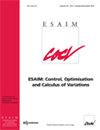Second–order analysis of Fokker–Planck ensemble optimal control problems
IF 1.2
3区 数学
Q4 AUTOMATION & CONTROL SYSTEMS
Esaim-Control Optimisation and Calculus of Variations
Pub Date : 2022-10-11
DOI:10.1051/cocv/2022066
引用次数: 3
Abstract
Ensemble optimal control problems governed by a Fokker–Planck equation with space–time dependent controls are investigated. These problems require the minimisation of objective functionals of probability type and aim at determining robust control mechanisms for the ensemble of trajectories of the stochastic system defining the Fokker–Planck model. In this work, existence of optimal controls is proved and a detailed analysis of their characterization by first– and second–order optimality conditions is presented. For this purpose, the well–posedness of the Fokker–Planck equation, and new estimates concerning an inhomogeneous Fokker–Planck model are discussed, which are essential to prove the necessary regularity and compactness of the control–to–state map appearing in the first–and second–order analysis.Fokker-Planck集合最优控制问题的二阶分析
研究了具有时空相关控制的Fokker-Planck方程的集合最优控制问题。这些问题需要概率型目标函数的最小化,并旨在确定定义福克-普朗克模型的随机系统的轨迹集合的鲁棒控制机制。在这项工作中,证明了最优控制的存在性,并详细分析了它们的一阶和二阶最优性条件的表征。为此,讨论了Fokker-Planck方程的适定性,以及关于非齐次Fokker-Planck模型的新估计,这对于证明一阶和二阶分析中出现的控制-状态映射的必要规则性和紧致性至关重要。
本文章由计算机程序翻译,如有差异,请以英文原文为准。
求助全文
约1分钟内获得全文
求助全文
来源期刊

Esaim-Control Optimisation and Calculus of Variations
Mathematics-Computational Mathematics
自引率
7.10%
发文量
77
期刊介绍:
ESAIM: COCV strives to publish rapidly and efficiently papers and surveys in the areas of Control, Optimisation and Calculus of Variations.
Articles may be theoretical, computational, or both, and they will cover contemporary subjects with impact in forefront technology, biosciences, materials science, computer vision, continuum physics, decision sciences and other allied disciplines.
Targeted topics include:
in control: modeling, controllability, optimal control, stabilization, control design, hybrid control, robustness analysis, numerical and computational methods for control, stochastic or deterministic, continuous or discrete control systems, finite-dimensional or infinite-dimensional control systems, geometric control, quantum control, game theory;
in optimisation: mathematical programming, large scale systems, stochastic optimisation, combinatorial optimisation, shape optimisation, convex or nonsmooth optimisation, inverse problems, interior point methods, duality methods, numerical methods, convergence and complexity, global optimisation, optimisation and dynamical systems, optimal transport, machine learning, image or signal analysis;
in calculus of variations: variational methods for differential equations and Hamiltonian systems, variational inequalities; semicontinuity and convergence, existence and regularity of minimizers and critical points of functionals, relaxation; geometric problems and the use and development of geometric measure theory tools; problems involving randomness; viscosity solutions; numerical methods; homogenization, multiscale and singular perturbation problems.
 求助内容:
求助内容: 应助结果提醒方式:
应助结果提醒方式:


